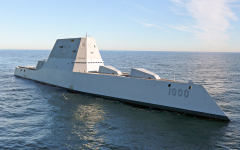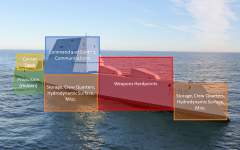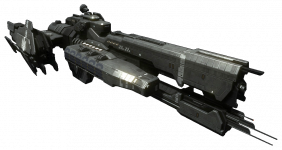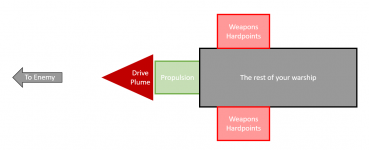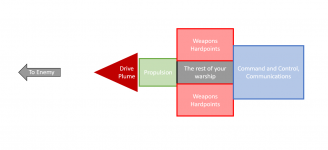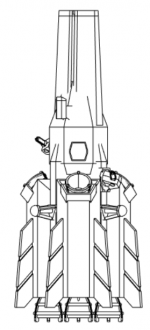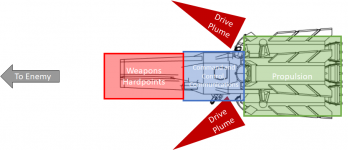To prelude this conversation I'd like to first direct your attention to the shape of a modern, seafaring warship:
This is the USS Zumwalt Class Destroyer. It has certainly met its fair share of controversy, but as a whole, it has the quintessential configuration of a modern surface combat warship.
Now here is the same image but with the primary functions outlined in boxes. With the exception of propulsion, which is hidden underwater, the other primary functions of the warship, command and control, weapons, carrier utility, are all apparent. The most dominant features of the warship hail from the primary functions. In other words, function determines form.
Thus, before we discuss the general layout of a space-faring warship, we need to characterize the environment it operates in, which will determine constraints, then strategy, then function, which therefore leads to form. First, as I've already discussed in this forum post, due to the high accelerations a spacecraft would undergo along its thrust vector, it's better to consider these warships as towers that have to withstand their own weight. Yet that along doesn't determine the shape of a warship, where its components are placed. Thus, something else must be considered: that space is big and empty.
Because space is so big and so empty, stealth is almost impossible and time between first observation and actual contact is non-negligible. Thus, almost always, you'll learn what your opponent's capabilities are and where they're heading. If your warship is on intercept course, you have two choices: either to slow down to match their flight path, to spend as much time as possible to put fire onto the enemy vessel; or to reverse course, increase distance, to keep them out of weapons range or flee entirely. Regardless, due to way physics works the end result is the same. Your warship will have its engine pointed at the enemy, either to decelerate towards them or to accelerate away from them.
This is the USS Zumwalt Class Destroyer. It has certainly met its fair share of controversy, but as a whole, it has the quintessential configuration of a modern surface combat warship.
Now here is the same image but with the primary functions outlined in boxes. With the exception of propulsion, which is hidden underwater, the other primary functions of the warship, command and control, weapons, carrier utility, are all apparent. The most dominant features of the warship hail from the primary functions. In other words, function determines form.
Thus, before we discuss the general layout of a space-faring warship, we need to characterize the environment it operates in, which will determine constraints, then strategy, then function, which therefore leads to form. First, as I've already discussed in this forum post, due to the high accelerations a spacecraft would undergo along its thrust vector, it's better to consider these warships as towers that have to withstand their own weight. Yet that along doesn't determine the shape of a warship, where its components are placed. Thus, something else must be considered: that space is big and empty.
Because space is so big and so empty, stealth is almost impossible and time between first observation and actual contact is non-negligible. Thus, almost always, you'll learn what your opponent's capabilities are and where they're heading. If your warship is on intercept course, you have two choices: either to slow down to match their flight path, to spend as much time as possible to put fire onto the enemy vessel; or to reverse course, increase distance, to keep them out of weapons range or flee entirely. Regardless, due to way physics works the end result is the same. Your warship will have its engine pointed at the enemy, either to decelerate towards them or to accelerate away from them.

